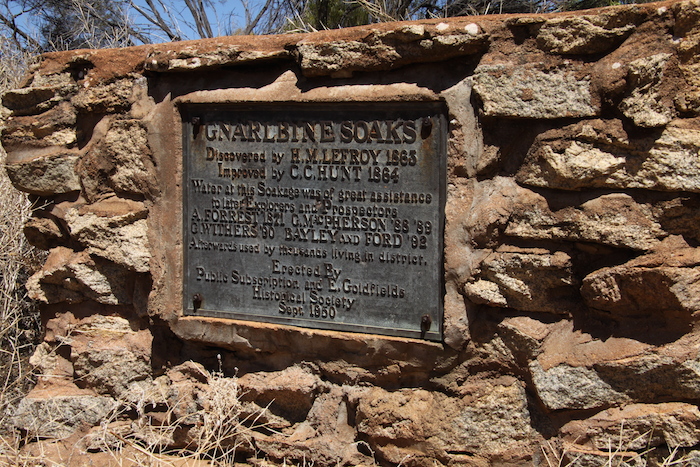In 1863 Henry Maxwell Lefroy (1818-1879) made an expedition to the area that was later to become known as the Eastern Goldfields. Lefroy led his party from York to assess the pastoral prospects to the east. The party covered 1600 kilometres during an eight week period in which men and horses were without water for long stretches. Lefroy makes no mention of Gnarlbine Soak in any of his diaries or field books although he did pass through this area.
In 1864 explorer/surveyor Charles Hunt (1832-1868) was sent by Governor Hampton and the York Agricultural Society to explore the country on which Lefroy had reported so favourably the previous year. It was on this expedition that Hunt applied the name ‘Gnarlbine’ to the Soak. He also named many of the other features in this area, including Lake Lefroy near Kambalda in honour of his predecessor of the year before.
19 July 1865 halt at Gnarlbine, … having a well to make here, the bullocks must suffer for a day or two as it is absolutely necessary to have a well sunk here, the distance from Camp 21 to Camp 23 being upwards of forty miles …
20 July 1865. Party engaged sinking well, ….
21 July 1865. Party engaged stoning up the well, … P.M. completed the well and removed the party about 18 miles to the westward …
Hunt made two other expeditions to the area, in 1865 and 1866, during which he improved the Soak.
Many other soaks and wells between Perth and this region were constructed by Hunt’s party during these expeditions. These have become known as ‘Hunt’s Wells’.
Gnarlbine became an important stopping place for explorers and prospectors, including R.J. Holland when he put through what today is known as the Holland Track. In the early days of Coolgardie, before the pipeline was built it was a vital supply of water.
The Eastern Goldfields Historical Society erected a monument and plaque at the base of the rock in 1950.
- Wall and plaque erected by the Eastern Goldfields Historical Society in 1950.
“GNARLBINE SOAKS”
Discovered by H.M. LEFROY 1863
Improved by C.C. HUNT 1864
Water at this Soakage was of great assistance
to later Explorers and Prospectors
A.FORREST 1871 G. MacPHERSON ’88 ’89
G.WITHERS ’90 BAYLEY and FORD ’92
Afterwards used by thousands living in district
Erected By
Public Subscription and E. Goldfields
Historical Society
Sept 1950
(Alexander) Forrest (1849-1901) was on his expedition from York when he used the Soak.
G.(Gillies) MacPherson (1844-1928) was a prominent prospector in this area and also the Kimberley.
The G. (George) Withers was also an active prospector in the area.
When John Holland (1856-1936) pushed his time-saving track through to the Goldfields from Broomehill in 1893, Gnarlbine Soak was one of the important stops.
The reports of the various trips, tours and travels on the Adventures website have a lot of information about place names – their naming and features – toponymy. More information.
© Kim Epton 2016-2024
495 words, one photograph.
Feel free to use any part of this document but please do the right thing and give attribution to adventures.net.au. It will enhance the SEO of your website/blog and Adventures.
See Terms of Use.

